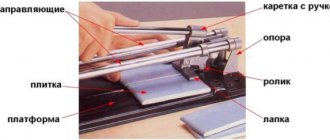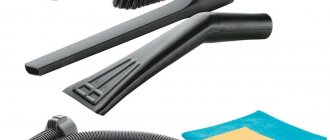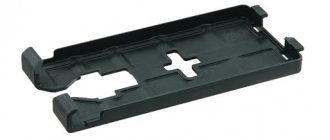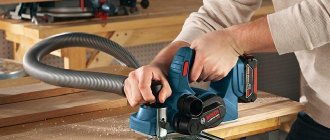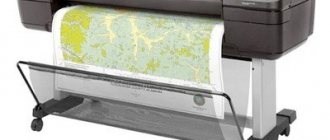Basic design and technological capabilities
Tile cutter is a generalized name for construction tools for straight, curved or even shaped cutting of tiles. The classification of the variety of these tools is based on the type of drive movement. So, tile cutters can be:
- Manual;
- Mechanized or electric.
A manual tile cutter consists of a base - a frame, a carriage with a roller and a handle. Its operating principle is similar to that of a regular glass cutter: a cutting roller is used to cut the glaze of the tile. At this moment it is clamped in the body like pliers. After obtaining a cut of the glaze, the tiles are broken off along it. To obtain a more even and accurate cut, guides are used that are adjusted to the tile clamping field. Sometimes tabletop manual tile cutter
An electric tile cutter is a device equipped with an electric drive that rotates a diamond cutting disc. The principle of operation of this version of the tile cutter is similar to a circular saw - the ceramic tiles move along the guide to obtain an even and neat cut. One of the varieties of mechanized tile cutter is a belt cutter, equipped with a diamond belt. To cool the tiles, water is supplied to the cutting area, which also washes away the cutting products.
In order to cut ceramic tiles correctly, you need to know how to use a tile cutter correctly .
Features of modern tile cutters
So, a tile cutter is a specialized tool designed for cutting finishing tiles made from various materials (ceramics, stone, porcelain stoneware, etc.) to form a high-quality cut.
The main structural components are:
- A cutting element, or roller, made of carbide steel.
- A goniometer, or protractor, in combination with a rotating ruler, provides the ability to cut tiles at an angle. Models of a high professional level can be equipped with a special device that allows you to cut round holes - a “ballerina”.
- Guides rigidly fixed in supports
- A foot whose functional purpose is to break tiles.
- A base or platform that provides a stable position for the tool.
- Handle.
However, knowledge of the design features of the tool does not guarantee a high-quality result.
The process of using a tile cutter as a cutting tool is characterized by several distinctive features:
- Possibility of making cuts at angles of 45 and 90 degrees.
- Providing high-quality and fast cutting.
- Ability to cut tiles for various functional purposes (cladding, flooring).
What are the advantages of using electric tile cutters?
You should purchase a machine for cutting tiles with water if you are processing durable materials at a professional level. The following advantages will help you make a positive decision about purchasing or renting a machine:
- Efficient cutting of materials of different thicknesses. Depending on the model of tile cutters, they allow you to cut parts of different thicknesses, which is very convenient, for example, when you need to get the appropriate size of a product. On machines, depending on the model, the maximum permissible thickness of materials that can be cut with a tile cutter is indicated.
- Lack of dust formation is one of the significant advantages, which is achieved due to the presence of a water cooling system
- High productivity - water during the cutting process lowers the temperature of the disk, eliminating its overheating. The diamond-coated wheel does not heat up and does not melt, so it lasts long enough and efficiently, eliminating engine overload
- You can cut any types of materials from tiles to glass
- Long service life not only of the machine, but also of the cutting disc. You can work on one disk for at least 2-3 years with daily appropriate manipulations
- The ability to obtain not only a straight cut at an angle of 90 degrees to the main surface of the material, but also at different angles, pre-setting the position of the disk
The ability to cut materials of different sizes depends on the dimensions of the table. That is why, before buying a machine, it is necessary to consider what materials you plan to cut - their thickness and dimensions. Electric tile cutters with a water cooling option have a number of disadvantages. These disadvantages must be taken into account immediately before purchasing machines.
Types of water cooling on tile cutters
Water is supplied to tile cutters through an auxiliary system consisting of a supply hose, which is connected to a container or reservoir containing water. The design also uses a pump responsible for pumping water from the reservoir to the work area.
The water supplied to the cutting area flows into another tank, which is located at the bottom of the table (under the tabletop). This reservoir fills up during operation, so it must be cleaned. Electric tile cutters use two types of water cooling systems:
- Conventional - when clean water from one reservoir is supplied to the working part, and then accumulates in another container. After filling the container, this water must be disposed of. The disadvantage of the system is that it is necessary to constantly add water to the first container
- Circulating in a circle - this option is more advanced, but has its drawbacks. Water from one container is supplied to the working part, and then enters another container, from where it is pumped back to the first. The disadvantage of the system is that water is re-supplied with dust and small particles, which negatively affect the pumping equipment
If the tile cutter does not have a water cooling function, then you can implement it yourself by using a bottle with a hole in the cork. During the cutting process, one person controls the cutting disc, and the second applies water to the working surface of the tool
Water-cooled electric tile cutter: advantages and disadvantages
The advantages of any thing can only be assessed by comparing its capabilities with a similar product, and an electric tile cutter is no exception. Let's start in order. A clean, smooth, and most importantly high-precision cut without chipping the edges of the tiles - only this tool can combine all these three advantages. For example, its manual counterpart also cuts tiles evenly - the accuracy and cleanliness of the cut is questionable. In fact, a manual tile cutter does not cut, but breaks the tile smoothly - the end of the tile is by no means smooth, as the diamond blade of an electric tile cutter makes it. You ask, what about the Bulgarian? It chips the edges of the tiles - unfortunately, without water cooling of the disc it will not be possible to make a smooth, high-quality cut. No dust. In principle, a manual tile cutter is also dust-free, but, unlike an electric one, it does not have the above advantages. Possibility to make cuts at an angle. No other tile cutting tool can cope with this task. Why are such cuts needed? Have you ever seen wall corners laid at 45˚? Believe me, they look much more attractive than corners lined with special corners. Trimming speed. This advantage of this tool will show itself well when laying tiles in large volumes - believe me, an electric tile cutter will give odds to its manual counterpart and even an angle grinder.
Don't miss: Installing polystyrene foam curtain rods
How to use a tile cutter
In addition, one cannot discount the nuance that, unlike a manual tile cutter, an electric one can be used to cut segments of any shape in tiles. If you really want to, you can even cut rectangular holes in the tiles. There is also a limited ability to make curved cuts of high purity - this, however, requires practice and dexterity. And in general, with the help of an electric tile cutter you can cut even the most durable tiles. For example, some types of porcelain stoneware designed for floor use cannot be cut with any other tool.
Stationary electric tile cutter photo
Rating of the best water-cooled electric tile cutters
Choosing a tool based on its characteristics is only half the job. Many tile cutters have the same parameters. Now comes the moment when among similar devices you need to determine the best model. The presented rating of 2019 water-powered electric tile cutters will help you make the right choice.
The video shows the installation of one of the popular tile cutters:
Best manual electric tile cutters
The category of manual electric models includes a tool that is similar in functionality to a grinder. Professionals rarely use such tile cutters due to large cutting errors and copious amounts of dust. However, the tool is perfect for home use.
STURM TC9811
Chinese tile cutter with good functionality for 2600 rubles
The advantage of a compact and powerful tile cutter is the presence of water cooling. The diamond wheel allows you to make an even cut. The tiles will never crack from overheating. It is possible to cut at an angle of 45 degrees. The electric model is multifunctional. If necessary, it can be used for cutting grooves.
BORT BHK-110-S
A Chinese tile cutter costs about 2,500 rubles
Among the top best manual electric tile cutters, the Chinese tool with a power of 1.2 kW is in the lead. The model works with cutting wheels with a diameter of 110 mm. The spindle reaches speeds of up to 12,000 rpm. The electric tool is capable of cutting tiles and porcelain stoneware. If necessary, a tile cutter can be used instead of a circular saw by installing an appropriate wood circle.
MESSER M125
A high-quality German tile cutter costs about 14,800 rubles
According to the parameters, the electric hand tool belongs to the professional class. The tile cutter is equipped with a hose and a water tank. High performance is ensured by a 1200 W motor. The spindle reaches speeds of up to 12,000 rpm. The maximum diameter of the diamond wheel is 125 mm. A tile cutter is a good assistant for a professional tiler when he has to carry out large amounts of work.
The best electric stationary tile cutters
Machines are considered the most effective tools, which provide all the nuances of convenient and high-quality cutting. The only drawback is the high cost, increased dimensions and weight. The machines are most often intended for professional use.
ELITECH PE 1200/12
The domestic model is produced in China, and its average cost reaches 26,000 rubles
A productive tile cutter is considered a professional type. At right angles, the machine can make cuts up to 52 mm deep. Engine power 1.2 kW. The spindle speed reaches 2950 rpm. The tile cutter works with diamond wheels up to 250 mm in diameter. Depending on the purpose, the disks are installed in a smaller size, but with an internal seat with a diameter of 25 mm. The disadvantage is the large weight of the electric machine - 64 kg.
FUBAG MASTERLINE 6 STAR – 660
A machine made by German manufacturers costs 20,800 rubles
In terms of functionality, the electric model has displaced more expensive tile cutters from the rating. Convenience has been thought through in everything. The manufacturer even provided a curtain to prevent dirt from splashing during cutting. The advantage is the small weight of the machine - 40 kg. If necessary, it can be easily moved to another place. The manufacturer provides a 2-year warranty on its equipment.
DIAM SPMAX-250/1.5
A tile cutter for 35,500 rubles is produced in China, but South Korea is considered the manufacturer
Electric tile cutting machine is popular because of its functionality. It is possible to cut at an angle, the carriage is height adjustable. Reliable fasteners are provided for the tiles. The tile cutter is equipped with a 1.5 kW motor. Maximum cutting length – 900 mm. At an angle of 42 and 45°, the cutting depth reaches 60 mm. The instrument is considered a professional one.
Basic criteria for choosing a tool
The quality of the work performed largely depends on the quality of the tool used in the work process. The correct choice of a tool, regardless of its design and basic operational characteristics, is ensured by the tile cutter meeting the following criteria:
- No external damage or defects. Controlled by performing a thorough external inspection of the product, test running it and checking adjustments.
- Geometric dimensions of the platform, length of the handle, rigidity of the base.
- Smooth running of moving elements.
- Possibility of cutting at an angle. In addition, you should pay attention to the ease and speed of setting the cutting angle, as well as the accuracy of the final result.
- The quality and material of the cutting disc.
- Includes spare parts and accessories included with the tool.
General tips for choosing
If you want to do all the repairs efficiently with your own hands, then you must approach even an inexpensive tool wisely. In this chapter we will give very important recommendations
How to choose the right disc for an electric tile cutter
The ceramic disc has no cuts or holes
A short guide to choosing cutting discs.
- The disc can easily jam when cutting thick tiles. This happens when he goes too deep into the material. Therefore, always refer to the device’s passport data.
- Pays attention to the type of cutting edge. For ceramic tiles, the discs will be smooth. They shouldn't even have ventilation holes.
Disc on stone
- The disk for the stone will be segmented, since here the requirements for heating temperature are higher. No, you can also cut tiles with it, but you will have a lot of chips on the edge.
- Look also at the manufacturer. Excellent wheels are produced by Bosch and Hilti - it’s not for nothing that they cost up to 5 times more than their Chinese counterparts. They last longer, and the quality of the cut is much better.
Electrical part of the machine
A 5-year warranty is serious
Regarding the electrical part, at first glance, no questions should arise, because tile cutters do not have speed control or soft start (as unnecessary), but not everything is so simple!
We are interested in the “insides” of the unit:
- Each device has a thermal relay in its electrical part that protects it from overheating.
- Some models are equipped with LED indicators that are activated when the tile cutter is working under excessive load. In this case, the pressure on the disc should be reduced.
- It is convenient when a manual electric tile cutter is equipped with a lock.
- It is also worth paying attention to the degree of protection of the device from electric shock (presence of an RCD, high-quality insulation from water, etc.).
Pleasant trifles
In conclusion, let’s name some gadgets that will make your work more comfortable:
- The machine must have clearly readable graduations in centimeters;
- The platform must be resistant to corrosion and easy to clean if necessary;
- It is very convenient when the device is equipped with a laser pointer;
- Convenient handles for transportation also come in handy;
- Simple disassembly of the tool for its maintenance;
- It is convenient when the bed has height-adjustable legs;
- Heavy machines must have wheels with stoppers;
- The power cord must be long enough.
The video in this article will tell you in detail about the electric tile cutter, which one to choose and how to work with it correctly. We are finishing our review. We hope you liked the material and find it useful in practice.
Principle of operation
A manual (mechanical) tile cutter is the choice of those who rarely cut material. In this case, the work is performed in two stages. The tile is fixed on the work table and cut with a special roller, after which it is broken along the applied mark. It is important to lubricate the guide frame and wheel before cutting (it is enough to apply a few drops of oil to these elements). In addition, the wheel must be firmly fixed and not “move” from side to side, otherwise the cut being made will not be straight and even. It is also worth periodically checking whether the cutter is worn out and, if necessary, replacing it with a new one.
To make the cut itself, mark the tiles with a marker, secure the material on the machine using a bounding frame so that the wheel coincides with the drawn line. Next, you need to apply the mark once with sufficient pressure.
Please note: it is best to do just one pass - this will make the tiles crack easier. If you make several cuts in one place, the chips will be uneven.
After the slot has been made, the tile is pressed with the carriage foot at the base. After this, the handle is lightly struck with the palm of your hand. Here it is also important to apply enough, but not too much force.
The final step is usually to process the cut if it is uneven. To do this, use several types of sandpaper (for processing tiles of different hardness) or a grinding stone. It is worth noting that this operation is not necessary if the edge is subsequently covered with another tile.
An electric tile cutter is a technique that comes in handy if you have to work frequently. In this case, the cut is performed in one pass with a water-cooled saw blade. This cutting method is the most effective for thick (up to 40 mm) workpieces.
Important! An electric tile cutter is not designed to cut tiles coated with carbide chips, as this will destroy the tooling. This type of material is cut by mechanical devices.
The principle of working with an electric tile cutter is as follows. Markings are placed on the tile and secured to the equipment work table using a clamping bar, or a straight or angular stop is used, which fixes the workpiece in the required position and at the same time serves as a guide. Next, the saw blade is started. When it reaches maximum speed, either the tile is moved under the disk with a certain force, or the saw head itself is guided along the tile by a special handle.
Water cooling of the contact point between the disk and the material is necessary to avoid overheating. The liquid washes away a large amount of abrasive dust and small fragments. Therefore, it must be changed frequently so that the saw equipment does not wear out quickly.
How to use a manual tile cutter?
In order to get an even cut line without damaging the ceramic tiles, you should follow simple rules:
Tools for cutting tiles.
- Before starting work, carefully check the condition of all elements of the tile cutter: the diamond roller should rotate without much effort, the movements of the carriage should be smooth, without jerking. Be sure to check the integrity of the roller - if chips or chips are found on its surface, the roller should be replaced by purchasing a new one at any building materials store. To make the movement of the roller on the surface of the tile smoother, apply a few drops of oil to it.
- The surface of the bed should be kept clean. No dirt, grains of sand or small fragments of tiles are allowed.
- Markings are applied to the tiles. To do this, use a construction pencil or marker with easily washable ink. The tile is placed on the bed in such a way as to align the cut line with the trajectory of the carriage.
- The handle is lowered until the diamond roller touches the surface of the tile. After this, with light pressure, pull the carriage towards you. Try to perform the operation in one pass, as otherwise the fracture may turn out uneven.
- After cutting the enamel, the carriage is placed in a position where it will be in the 1/3 of the tile closest to you. The handle is pulled down, during which special “wings” press on both parts of the tile, easily breaking it.
Don't miss: Technologies for laying ceramic tiles on a wooden floor in a bathroom. Proper screeding and laying tiles on a wooden floor in the bathroom
Scheme for cutting tiles with a glass cutter.
A manual tile cutter allows you to separate pieces of tiles with a width of 5-6 mm (depending on the thickness of the material). If you need to cut a narrower strip, you can make a cut with the diamond roller of the device, and then, using pliers, gradually break off the excess part of the tile.
During operation, metal “wings” can leave small marks and chips on the enamel surface. In order to avoid this, some craftsmen glue pieces of electrical tape to their lower surface.
Professional models of manual tile cutters have adjustable guides with markings in inches and centimeters that can be fixed in a given position. This allows you to avoid marking the tiles, which makes working with large volumes much easier. The guides also move at different angles, making shape cutting possible.
The cost of professional tile cutters is quite high and depends not only on functionality, but also on the manufacturer. Some devices are also equipped with a so-called ballerina. This is a simple mechanism that allows you to cut round holes in tiles for sockets and switches. At first glance, the presence of this function greatly simplifies the work, but in most tile cutters the “ballerina” works very incorrectly. Therefore, it is easier to make a hole with a regular round tile crown.
A manual tile cutter has some limitations for work: it can easily cope with tiles whose thickness does not exceed 12 mm. It is also quite difficult (and sometimes simply impossible) for them to cut hard surfaces: porcelain stoneware, granite and tiles made from other natural materials. For such cases, a rational solution would be to use electrically driven devices.
How to cut tiles
The process of high-quality, fast and easier cutting of ceramic tiles is ensured by performing some simple measures. They are as follows:
- Pre-soaking the tiles in moderately warm water almost completely eliminates the appearance of chips and cracks during the cutting process, and therefore significantly minimizes the amount of scrap.
- Periodically lubricate the cutting roller and marking line with machine oil, thereby reducing the coefficient of friction.
- Move the carriage using even hand pressure in a smooth, non-jerking motion, making only one cut.
Having completed all the preparatory activities, you can proceed directly to the work process.
So, how to use a manual tile cutter correctly:
- Using a marker and ruler, mark the ceramic product to be cut.
- Place the product on the working surface of the tool platform and secure it with clamps so that the line of the marking you made is exactly under the wheel of the cutting element. To facilitate this process, there is a central mark on the tile cutter bed.
- While moving the handle, place the cutting part roller at the beginning of the marking line (closest to you) and press it lightly.
- In the direction “away from you”, evenly and smoothly move the carriage with the cutting element along the line of the applied marking, making a small depression in the front layer of the product being cut.
- Move the handle to the non-working position and place the presser foot at the center point of the resulting cut.
- Using gentle pressure (impact), break the product into two parts.
Cutting porcelain stoneware
Porcelain stoneware or gres is characterized as a finishing material with increased hardness, which introduces certain nuances into the process of cutting it using a manual tile cutter. For example, the material used to make the tool must be more durable, and the cutting element must be defect- and wear-resistant.
Otherwise, the procedure remains similar to the procedure described above.
As a rule, the thickness of porcelain stoneware, which is cut with a manual mechanism, does not exceed 15.0 millimeters.
Safety rules when working with the tool
Before cutting tiles using a manual tile cutter, you should check the tool for serviceability. The safety of the person performing the work depends on this. Despite the fact that hand tools are less dangerous than electric ones, it is important to follow the following safety rules when working with them:
- Even if you hold the tile being cut with one hand, be sure to control the position of your hand. The cutter is quite sharp, so you should not place your fingers close to it. When cutting tiles correctly, only one hand is used to hold the handle of the tool.
- It is recommended to carry out work wearing gloves and safety glasses.
- Prepare your workplace. If the work is carried out at the site where the tiles are laid, then it is necessary to equip the place where the tile cutter will be located.
If, after reading this information, you have difficulty cutting tiles, then the reason may not only be a lack of experience. Most often, cheap Chinese tile cutters are purchased, which have a very short service life. To prevent this from happening, buy proven and branded tile cutters.
Working with an electric tile cutter
The electric analogue, in its operating principle, is not much different from the manual one. The meaning is the same, but there are certain differences.
Some types of tiles are made from fairly hard materials, and can even be larger in size than those tiles that could once be cut using a regular glass cutter. In this case, there will be only one answer to the question of how to cut tiles - with an electric tile cutter.
Working with an electric tile cutter with water supply to cool the tiles
It is indispensable for large volumes of work, however, there are certain difficulties: cost, and experience is still desirable here.
However, for those who don’t have it, don’t despair, this is a real deal, and now we’ll look at how to cut tiles with an electric tile cutter.
The tile cutter itself is very similar to a circular saw, the only difference is that it is equipped with a special bath for water, as well as in the discs that are used when cutting ceramic tiles with this type of tool.
So, pour the liquid into the bath, making sure that the disk is covered by about 2-3 cm.
Next, everything is simple, take the tile, and, pressing it to the surface, carefully, without unnecessary pressure, bring it to the rotating disk.
An undeniable advantage of an electric tile cutter: it is possible to make a cut at an angle, which automatically gives you the opportunity to carefully lay tiles in the corners, without purchasing special plastic corners for finishing.
That's basically all - now each of you knows how to cut tiles with a tile cutter without any problems or costs!
| Grout “Prospectors”: from choosing to applying it yourself |
| Installation of clinker tiles on the facade |
| How to use a manual tile cutter yourself? |
| What and how to wash ceramic tiles |
I would like to clarify that when cutting tiles with a manual tile cutter, the cut itself often turns out uneven. Any tips to make it neater or how to hide these little imperfections?
There are several options - you can process the edge with a grinding stone, however, if there are a lot of irregularities, then this process will be lengthy, and you can also chip off the glaze while working. The most optimal way is to hide the cut when joining; usually the cuts are made at the corners, so you will need to place a whole tile on the cut, hiding it. You can also use special corners that will hide the cut - it looks neat and the chips are completely invisible.
Tips for using the tool
- If you are choosing a tool for one-time use, an inexpensive model, for example, from a Chinese manufacturer, will do. For reusable use, it is advisable to buy a manual professional tile cutter - it will last for many years.
- Regardless of whether you are cutting porcelain stoneware with a tile cutter or ceramics, take into account the diagonal length of the die. It is desirable that the length of the working section be greater and in no way less than the diagonal of the finishing element.
- Before you start cutting, you need to drip machine oil onto the surface of the roller. This solution will significantly reduce the friction between the roller and the die - this will help improve the quality of the cut.
- To ensure that the break turns out the way it should, do not rush, do not make sudden movements. The movement of the crown should be smooth and unhurried. Make sure that the box does not get stuck while driving.
- Pay attention to the roller, it should not have a loof.
Sources:
- https://keramtile.ru/remont-polov-i-sten/kak-polzovatsya-plitkorezom.html
- https://pochini.guru/sovety-mastera/kak-polzovatsya-samodelnyim-plitkorezom
- https://moiinstrumentu.ru/vybiraem-dlja-raboty-jelektricheskij-plitkorez-s-vodnym-ohlazhdeniem.html
- https://www.sanyo-electric.ru/elektricheskij-plitkorez-ustrojstvo-raznovidnosti-i-prakticheskoe-ispolzovanie/
- https://www.vseinstrumenti.ru/stanki/plitkorezy/articles/950/
- https://masterinstrumenta.ru/info/kak-polzovatsya-plitkorezom.html
- https://InstrumentyvDom.ru/ruchnoj/kak-polzovatsya-plitkorezom
- https://plitkahelp.com/rezka/kak-rezat-plitku-ruchnym-plitkorezom
How to cut tiles
The principle of operation of a tile cutter is simple and similar in action to an ordinary glass cutter. When moving, the pressed diamond roller cuts a groove along which a fracture is subsequently made. The difference is in the improved design - roller guides, durable fastenings and the presence of a lever make it possible to cut grooves on the tile glaze with force. To properly cut tiles with a manual tile cutter, you need to consider all the steps in detail.
The secret is to make the tile pliable and avoid splitting and crumbling, cover it with a wet cloth or soak it in water 1.5-2 hours before cutting.
Before cutting, place a drop of machine oil on the surface of the roller. This reduces friction and improves cut quality.
Roller tile cutter
The instructions for using a manual mechanical device outline the following procedure for cutting tiles with a tile cutter.
- Place the plate face up on the bed, positioning the diamond cutter exactly above the marked cut line.
- To prevent displacement, the tiles are rested against the stop located in the frame.
- If it is necessary to cut a small strip, a stop must be placed under the main hanging part for stability at the same height as the bed.
- Afterwards, holding the lever, the carriage is put into working condition, the support legs are bent, and the diamond cutter is placed on the marked cutting line.
- Pressing the lever, roll the roller along the drawn line. You cannot rush or make sudden movements; the stroke of the cutter should be smooth, with uniform pressure.
If you apply light pressure and get a shallow furrow, you should not go through it again with a cutter. When cutting again, the edges begin to crumble, resulting in a sloppy cut.
When working, it is worth considering that a manual tile cutter cannot cut strips less than 1 cm wide. If necessary, break off the edge with wire cutters. The same method is used to make a figured edge. For those cutting tiles for the first time, it is better to practice on defective or broken tiles. There is a design of a mechanical tile cutter on bearings, which is designed for plates with a thickness of more than 16 mm.
Tile cutter-tongs
For small amounts of work, it is convenient to cut the tiles with a tile cutter-tongs. This is an inexpensive, practical tool. It looks like large nippers; on the side there is a sharpened roller, which is used to make a furrow along the marked line. The sharp part of the jaws of the forceps is intended for installation on the groove of the front part, the smooth foot is located at the bottom. Then gently press the handles, which ensures an even break. It is advisable to keep the die low above the table so as not to break it if accidentally dropped. These tongs can be used to bite off thin strips.
Electric tile cutter
Working on an electric machine is advisable for professional workloads, since the equipment is expensive. The operating principle is based on cutting with a diamond wheel; a stream of water is automatically supplied to the cut site, which cools the disc and washes away the resulting dust. Precisely controlled movements of the diamond blade provide a perfectly straight cutting line, which allows you to join tiles at outer corners without decorative overlay strips. There are both portable lightweight models and stationary floor-mounted machines.
